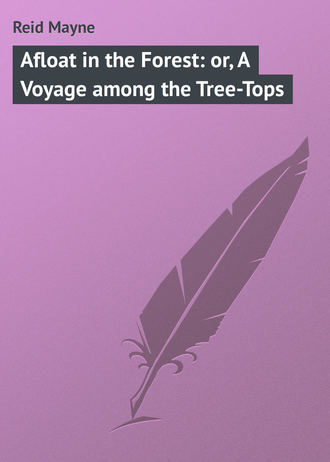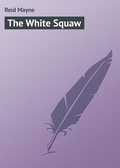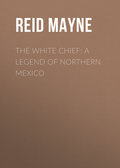
Майн Рид
Afloat in the Forest: or, A Voyage among the Tree-Tops
Chapter Sixty Three
The Tamandua: The Ant-Thrush
Trusting to the explanation given by the tapuyo, they did not think of inquiring further into the cause of the commotion among the ants. While scanning the tree closely, several of the party perceived a movement among its branches, and soon after the form of a singular creature that was causing it. It was a quadruped, about the size of a raccoon or cat, but of a shape peculiarly its own. Its body was long and cylindrical, terminating posteriorly in a round, tapering tail, while its low, flat head, prolonged into a smooth, slender muzzle, also tapered nearly to a point. The eyes were so small as scarcely to be seen, and the mouth more resembled a round hole than the closing of a pair of jaws. It was covered with a dense silky fur, of a uniform length over the body, and slightly crisped, so as to give it a woolly aspect. This fur was straw-coloured, with a tinge of maroon and brown on the shoulders and along the back, while the tail presented a ringed appearance from an alternation of the two colours.
“Tamandua!” exclaimed Munday, at sight of the strange quadruped. “The ant-eater. Not the great one, which is called Tamandua assu, and don’t climb up the trees. That you see is the little one; he lives all his life among the branches, – sleeps there, either upon his breast, or suspended by his tail, – travels from one tree to another in search of honey, bees, wasps, grubs, but, above all, of such ants as make their nests either in holes, or stick to the twigs. Ha!” he continued, “what could I have been thinking of? The tocandeiras wishing to climb up to the tree? Not a bit of it. Quite the contrary. It’s the tamandua that’s keeping them in motion! See the cunning beast preparing to make a descent among them!”
Nothing could be more certain than that this was the tamandua’s intention; for almost on the instant it was seen to move among the branches, descending from one to the other, partly using its strong, hooked claws, and partly its tapering and highly prehensile tail. Once upon the dead-wood, it lay flat down upon its breast and belly; and shooting out its long, thread-like tongue, coated with a sticky shining substance resembling saliva, it commenced licking up the tocandeiras that swarmed in thousands around it. It was to no purpose that the ants made an attack upon it. Nature had provided it with an armour proof both against their bite and sting. Rage around it as they might, the tocandeiras could do nothing to hinder it from licking them up from the log, and tucking them in hundreds into its capacious stomach. Finally the tamandua had taken his fill, – breakfasted to his heart’s content; then, erecting himself on his hind-legs after the manner of a squirrel or marmoset, he sprang back upon the branch from which he had descended. Going a little higher up, he selected another and larger branch, placing himself so that his belly rested along its upper surface, with the legs hanging down on each side; and then, burying his proboscis in the long fur of his breast, and taking two or three turns of his tail around head, body, and legs, he fell fast asleep.
The old saw, that there is “many a slip between the cup and the lip,” is as true in the life of ant-eater as in that of a man; and when the tamandua awoke, – which it did some twenty minutes afterwards, – and looked down upon the dead-wood, it was astonished to discover that not a tocandeira was in sight.
What had become of them? When left by the tamandua to their own devices there were myriads still surviving. The few thousands which the devourer licked up had made no perceptible diminution in their numbers; and on the retiring of their enemy, they were swarming as thickly and countlessly as ever. Now not one was visible upon the log, the hue of which, from being of a flaming red, had returned to its original colour of sombre grey. A few were discovered upon the standing tree, crawling up its trunk and lower branches, with excited air and rapid movements, as if escaping from terrible disaster. These refugees did not amount to many hundreds; thinly scattered over the bark, they could have been counted. They were too few to tempt the hunger of the tamandua. It would not have been worth his while to project his slimy tongue for the sake of a single tocandeira; so he retained it – not behind his teeth, for he had none – but within the cylinder-shaped cavity of his mouth. What had become of the tocandeiras? It is possible that the tamandua mentally put this question to himself; for there is no animal, however humble its organisation, that has not been gifted by beneficent Nature with a mind and powers of reasoning, – ay, with moral perceptions of at least the primary principles of right and wrong, as even the little ant-eater gives evidence.
Perhaps you have yourself witnessed the proof. You have seen one ant rob another of its crumb of bread, that by a laborious effort has been carried far. You have seen the companions of both gather around the spot, deprive the despoiler of its ill-gotten prize, restore the crumb to its lawful possessor, and punish the would-be pilferer. If you have not seen this, others have, – myself among the number. Surely, it is reason; surely, it is moral perception. If not, what is it? The closet-naturalist calls it instinct, – a ready word to cloak that social cowardice which shrinks from acknowledging that besides man there are other beings upon the earth with talents worth saving.
Soon after the ant-eater had gone to sleep, a little bird about the size of a starling was seen flitting about. It was of the ordinary shape of the shrikes, or fly-catchers, and, like them, of sombre plumage, – a dull grey blended with bluish slate. As already said, it was flitting about among the tree-tops, now and then rising above them, and hovering for a while in the air; then lighting again upon a branch, and from this hopping to another, and another, all the time giving utterance to twittering but scarcely musical notes.
“An ant-thrush,” Munday said. “It’s hunting about for the very creatures that are swarming on that log. If it should spy them we’ll have no more trouble with the tocandeiras. That friend will clear them out of our way. If it but gets its eye on that red crowd, it’ll treat them very differently from what the beast has done. In twenty minutes there won’t be a tocandeira to sting us. May the Great Spirit prove propitious, and turn its eyes upon the dead-wood!”
For a time the bird kept up its flickering flight and twittering cry, while our adventurers watched it manoeuvres, keeping quiet, as a precaution against scaring it away. All at once the ant-thrush changed its tactics, and its louder note proclaimed a surprise. It had come close to the tree that contained the tamandua, and saw the quadruped taking its siesta upon the branch. From the presence of the ant-eater it argued the proximity of their common prey.
The swarm of fire-ants, reddening the log, formed too conspicuous an object to escape being seen. The ant-thrush soon saw them, and announced the discovery with a screech, which was a signal to scores of hungry companions. It was answered by what seemed a hundred echoes, and soon the air resounded with whistling wings, as the feathered ant-eaters came crowding to the feast.
Boy reader, you have bred pigeons, and fed them too. You have flung before them whole baskets of barley, and pecks of oats, until the pavement was thickly strewed. You have observed how quickly they could clear the ground of the grain. With the like rapidity was the log cleared of the tocandeiras. In ten minutes not a single insect could be seen upon it; and then the feathered ant-eaters, without giving the tamandua a hint that his premises had been despoiled, flew off into the forest in search of a fresh swarm.
Chapter Sixty Four
Ant-Eaters – Biped and Quadruped
The spectacle of the bird ant-eaters engaged in their work of destruction is one that may be seen almost every day in the Amazonian region. The presence of an army of ants passing from place to place through the forest – themselves often bent upon a marauding and murderous expedition – may often be discovered long belong the insects themselves are in sight, by the twittering cries and excited actions of the ant-thrushes, that in large flocks are seen hovering above them. The traveller takes warning by the spectacle. Experience has long ago taught him that to stray into the midst of a party of foraging ants is no slight matter. It would be like dancing an Irish jig over a nest of hornets. He is sure of being attacked, bitten, and stung by the venomous insects; and on hearing the call of the ant-thrush, he beats an instant retreat. The quadruped licking up his insect prey is a sight of less frequent occurrence.
Of these four-footed ant-eaters there are many distinct kinds, differing very considerably in their habits of life. Four species are known to naturalists; but it is probable that there are many more yet to be discovered and described. The Indians who are best acquainted with the remote haunts of the great mountain wilderness of interior South America assert that there are others; and their testimony is generally derived from acute observation. Of the four known species there is the great ant-eater (Myrmecophaga jubata) called Tamanoir, large as a mastiff dog, and a match for most dogs in strength, often even killing one by squeezing the breath out of his body between its thick, muscular fore-limbs. This is the Tamandua bandeira, or “banner tamandua” of the natives, so called from the peculiar marking of its skin, – each side of the body being marked by a broad blackish band running obliquely from the shoulders, and suggesting the resemblance of an heraldic banner. It lives in the drier forests, making its haunt wherever the white ants (termites), those that construct the great hills, abound. Of the habits of this species a more complete account has been given elsewhere. (See “The Forest Exiles,” by the author of this story.)
The second species of tamandua – that is, in size – is quite a different creature. It scarcely ever descends to the earth, but passes from branch to branch and tree to tree by means of its strong, curving claws, and more especially by the aid of a very long and highly prehensile tail. Its food consists exclusively of ants, that construct huge earthy nests high up among the branches or against the trunks of the trees, where they present the appearance of grotesque excrescences. This tamandua often moves about during the day, in its slow progress much resembling the sloths, though its food is so very different from the animal of the Cecropia-tree (bicho de embaüba). This species dwells chiefly in the thick forests, and goes into the Gapo at all seasons of the year, and it was one of this sort which the party had seen.
But there are still two other kinds that make their home upon the trees, – both exceedingly curious little animals, and much more rarely seen than the large tamanduas. They are distinguished by the name of tamandua-i, which in the Indian language means “little tamandua.” One of them, the rarest of the family, is about the size of a half-grown kitten. Instead of hair, it wears a fine wool of a greyish-yellow colour, soft and silky to the touch. The other is of the same size, but dingy brown in colour, and with hair of a coarser kind. These little ant-eaters both sleep through the day, curled up in the cavity of a tree, or in some fork of the branches, and only display their activity by night.
Thus it is that the ants have no chance of escaping from their numerous enemies. On the earth they are attacked and destroyed by the great ant-eater, in the trees by his brother with the four curving claws. By day one species preys upon them, – by night, another. Go where they will, there is a foe to fall upon them. Even when they seek security under the earth, there too are they pursued by enemies of their own tribe, the savage ecitons, which enter their subterranean dwellings, and kill them upon their own hearths, to be dragged forth piecemeal and devoured in the light of the sun!
Chapter Sixty Five
The Chase of the Tamandua
If the tamandua had been surprised by the disappearance of the tocandeiras, it was not less so to see approaching a creature more than ten times its own size. This creature was of a dark bronze colour, having a long, upright body, a pair of legs still longer, arms almost as long as the legs, and a roundish head with long black hair growing out of its crown, and hanging down over its shoulders. If the ant-eater had never before seen a human being, – which was probable enough, – it saw one now; for this creature was no other than old Munday, who had taken a fancy to capture that tamandua. Perhaps the little quadruped may have mistaken him for an ape, but it must have also thought him the grandest it had ever set eyes upon. Swinging itself from branch to branch, using both claws and tail to effect its flight, it forsook the tree where it had slept, and took to another farther into the forest. But Munday had anticipated this movement, and passed among the branches and over the matted llianas with the agility of an ape, – now climbing up from limb to limb, now letting himself down by some hanging sipo.
He was soon joined in the pursuit by Richard Trevannion, who was an expert climber, and, if unable to overtake the ant-eater in a direct chase, could be of service in helping to drive it back to the tree it had just left, and which stood at the end of a projecting tongue of the forest. It is possible that Munday might have been overmatched, with all his alertness; for the tamandua had reached the narrowest part of the peninsula before he could get there. Once across the isthmus, which consisted of a single tree, it would have had the wide forest before it, and would soon have hidden itself amid the matted tangle of leaves and twigs. Richard, however, was too cunning to let the ant-eater escape him. Dropping into the water, he swam towards the isthmus with all his strength, and reached the tree before the tamandua.
By this time Munday had arrived from the opposite quarter, and was already climbing into the same tree. Seeing itself intercepted on both sides, the tamandua began crawling up towards the topmost branches. But Munday was too quick for it, and springing after, with the agility of a cat, he caught hold of it by one of the hind-legs. Being an animal insignificant in size, and apparently in strength, the spectator supposed he would speedily have dragged it down. In this however they were mistaken, not taking account of the power in its fore-limbs and tail.
Notwithstanding the tapuyo exerted all his strength, he could not detach it from the tree; and even when assisted by his companion, was only able to get the fore-legs free. The tail, lapped several times around a limb, resisted all their efforts. But Munday cut the clinging tail with his knife, leaving two or three of its rings around the branch. Then, twisting the stump around his wrist, he swung the animal back against the trunk with a force that deprived it at once of strength and life.
Chapter Sixty Six
Roast Ant-Eater
Instead of returning to the tree, the Indian and Richard swam directly to the dead-wood, where they were quickly joined by the rest of the party. Although the dead-wood was as hard as any other wood, and to sleep upon it would be like sleeping on a plank, still it would give them the feeling of security; so, as if by general consent, though nothing was said, they stretched themselves along the trunk, and were soon fast asleep.
The old Indian, tough as the sipos of his native forests, seemed as if he could live out the remainder of his life without another wink of sleep; and when the rest of his companions were buried in profound repose, he was engaged in an operation that required both energy and the most stoical patience. In a place where the bark was dry, he had picked out a small circular cavity, beside which he had placed some withered leaves and dead twigs collected from the tree that spread its branches above. Kneeling over this cavity, he thrust down into it a straight stick, that had been cut from some species of hard wood, and trimmed clear of knots or other inequalities, twirling it between the palms of his hands so as to produce a rapid motion, now one way, now the other. In about ten minutes a smoke appeared, and soon after sparks were seen among the loose dust that had collected from the friction. Presently the sparks, becoming thicker, united into a flame; and then, dropping the straight stick, he hastily covered the hole with the dry leaves and chips, and, blowing gently under them, was soon cheered by a blaze, over which a cook with even little skill might have prepared a tolerable dinner. This had been Munday’s object; and as soon as he saw his fire fairly under way, without dressing or trussing the game, – not even taking the hide off, – he laid the tamandua across the fire, and left it to cook in its skin.
It was not the first time by scores that Munday had make that repast, known among Spanish-Americans as carne con cuero. He now proceeded to prevent the spreading of the flames. The dead-wood around was dry as tinder. Stripping off the cotton shirt that, through every vicissitude, still clung to his shoulders, he leant over the side of the floating log, and dipped it for several minutes under the water. When well soaked, he drew it up again, and taking it to the spot where the fire was crackling, he wrung the water out in a circle around the edge of his hearth. When the tamandua was done brown, he then awakened his companions, who were astonished to see the fire, with the bronzed body of the Indian, nude to the waist, squatting in front of it, – to hear the crackling of sticks, the loud sputtering of the roast, and the hissing of the water circle that surrounded the hearth. But the savour that filled the air was very agreeable. They accepted his invitation to partake of the repast, which was found greatly to resemble roast goose in taste; and in an inconceivably short time only the bones of the ant-eater, and these clean picked, could be seen upon the ceiba.
Chapter Sixty Seven
The Juarouá
Postponing till the next day the task of making a canoe out of their log, the party soon betook themselves to rest again; but they had been slumbering only about an hour when a low whimpering noise made by the monkey awoke Tipperary Tom, close to whose ear the animal had squatted down. Its master raised himself up, and, leaning upon his elbow, looked out over the Gapo. There was nothing but open water, whose smooth surface was shining like burnished gold under the beams of the setting sun. He turned toward the trees. He saw nothing there, – not so much as a bird moving among the branches. Raising his head a little higher, and peeping over the edge of the dead-wood, “It’s thare is it, the somethin’ that’s scyarin’ ye?” he said to his pet. “An’ shure enough there is a somethin’ yandher. There’s a ‘purl’ upon the wather, as if some crayther was below makin’ a disturbance among the weeds. I wondther what it is!”
At length the creature whose motion he had observed, whatever it was, came near enough for him to obtain a full view of it; and though it was neither a snake nor a crocodile, still it was of sufficiently formidable and novel appearance to cause him a feeling of fear. In shape it resembled a seal; but in dimensions it was altogether different, being much larger than seals usually are. It was full ten feet from snout to tail, and of a proportionate thickness of body. It had the head of a bull or cow, with a broad muzzle, and thick, overhanging lip, but with very small eyes; and instead of ears, there were two round cavities upon the crown of its head. It had a large, flat tail, not standing up like the tail of a fish, but spread in a horizontal direction, like that of a bird. Its skin was smooth, and naked of hairs, with the exception of some straggling ones set thinly over it, and some tufts resembling bristles radiating around its mouth and nostrils. The skin itself was of a dull leaden hue, with some cream-coloured spots under the throat and along the belly. It had also a pair of flippers, more than a foot in length, standing out from the shoulders, with a teat in front of each, and looking like little paddles, with which the huge creature was propelling itself through the water, just as a fish uses its fins or a man his arms.
The Irishman did not stay to note half of these characteristics, but hastily woke Munday, crying, “What is it? O what is it?”
The Indian, rousing himself, looked round for a moment dreamily, and then, as he caught sight of the strange object, replied, “Good fortune! it is the juarouá.”







